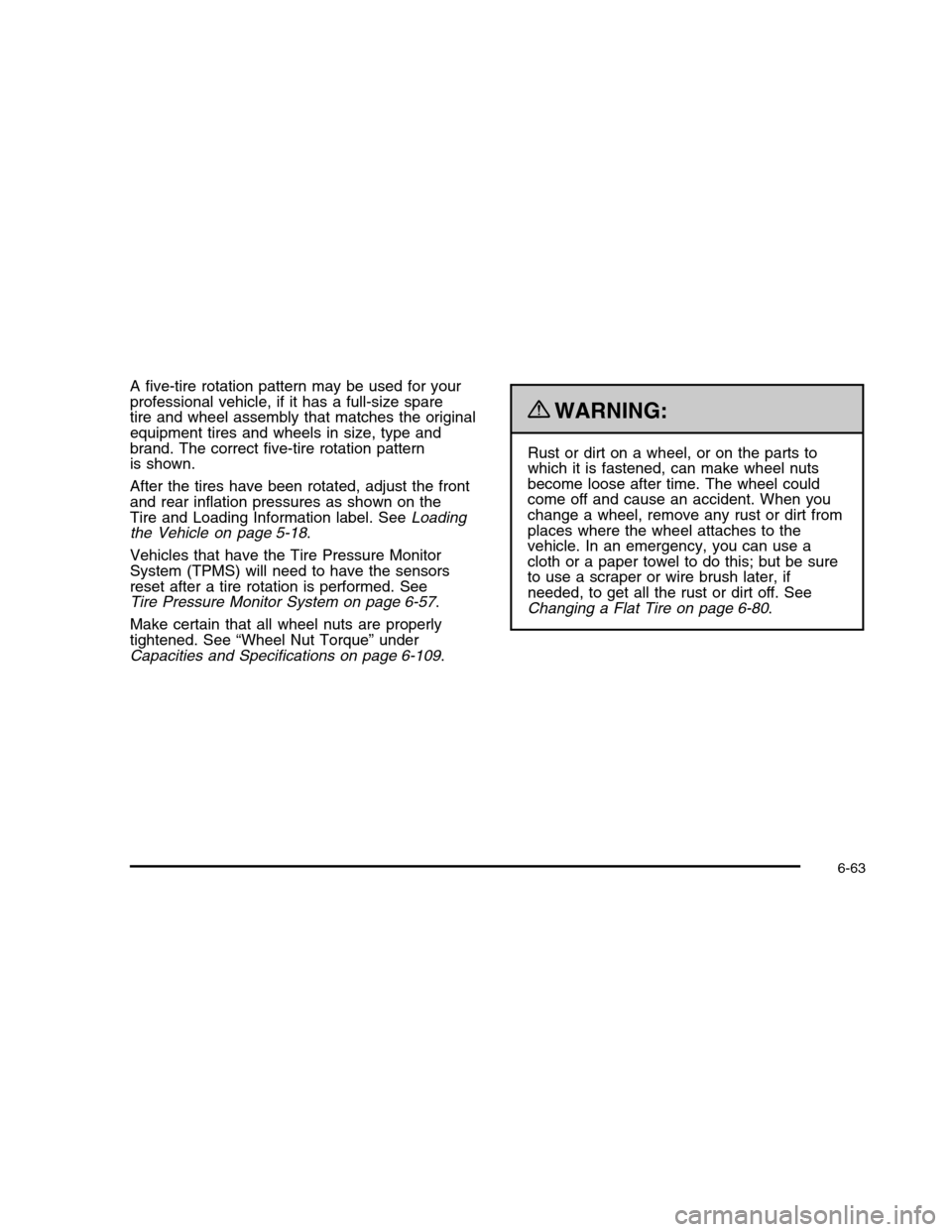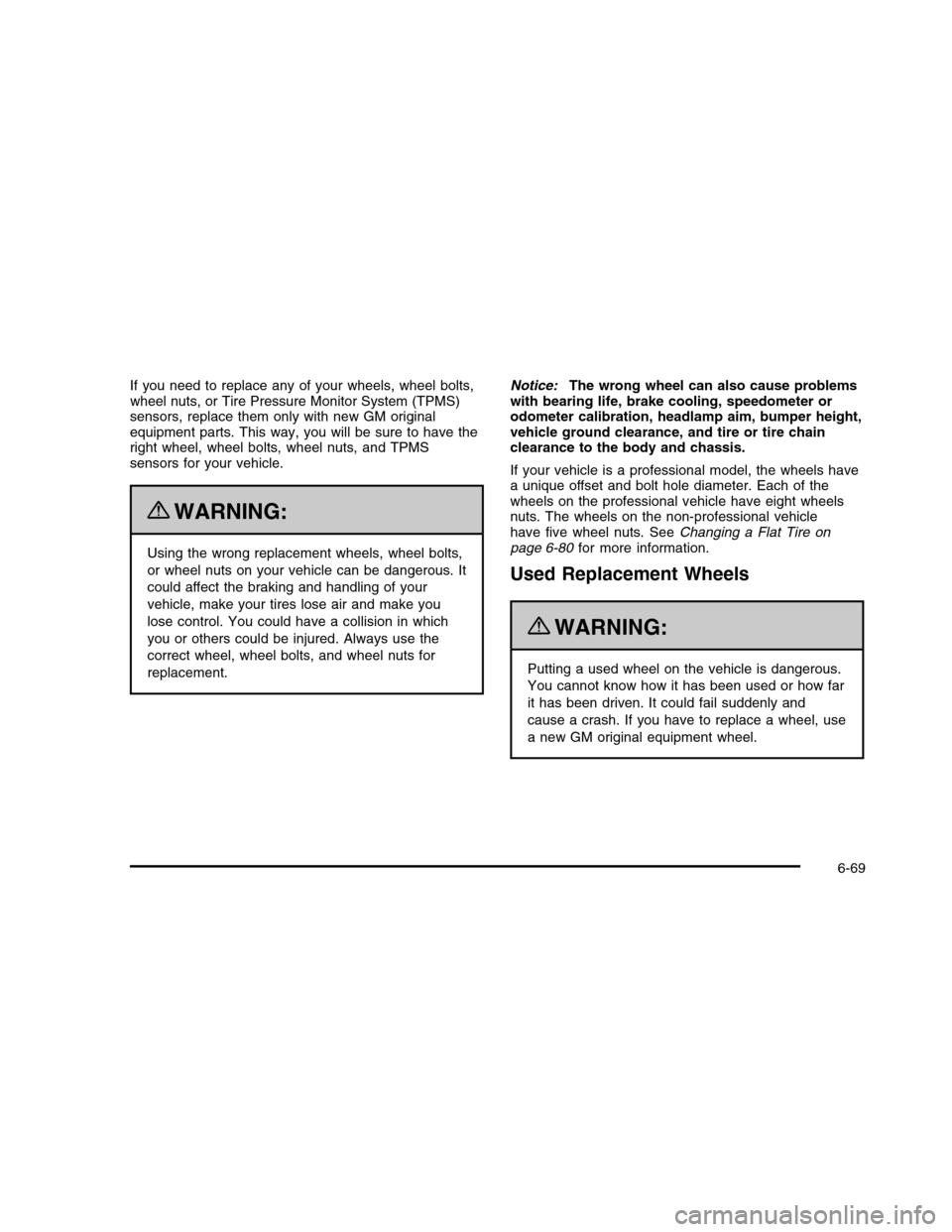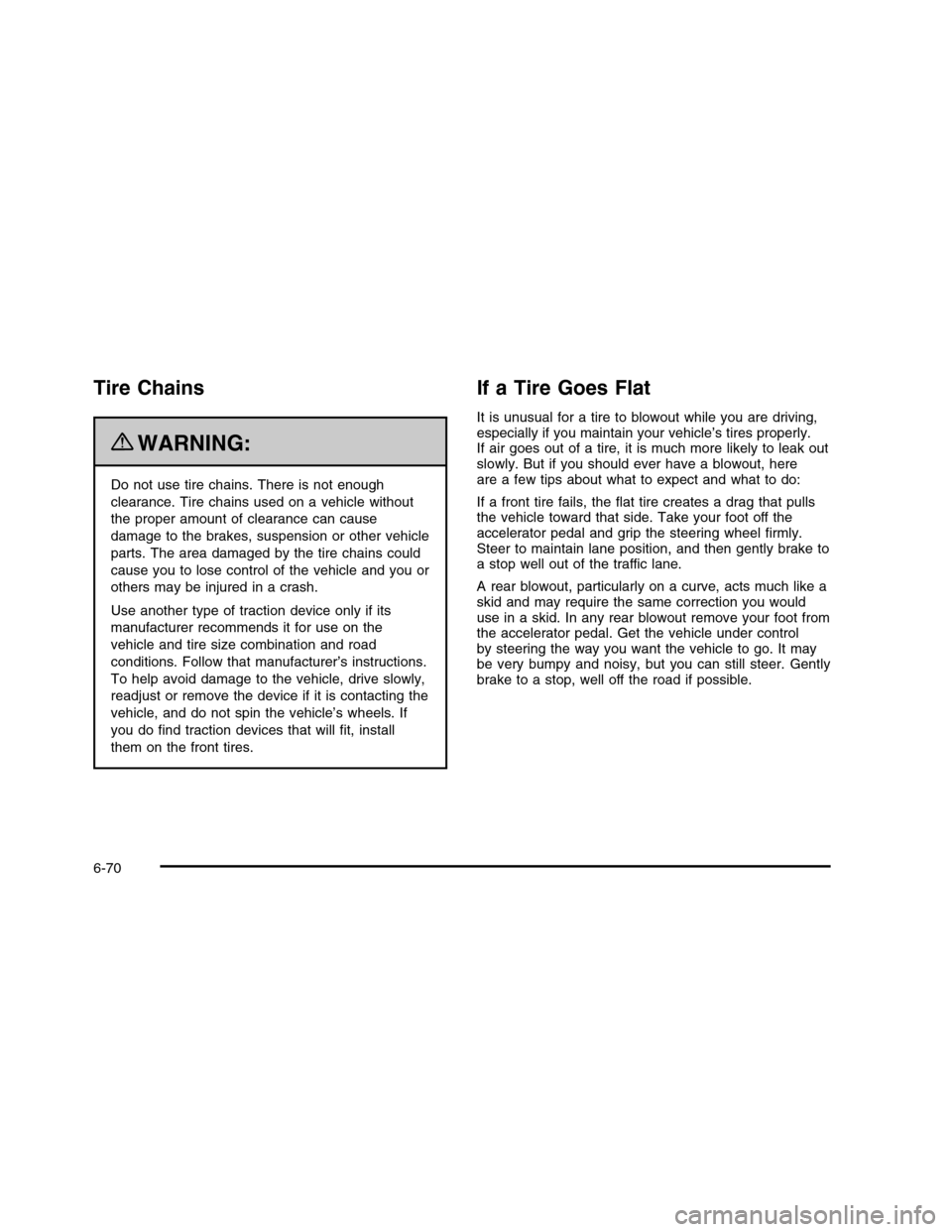flat tire CADILLAC DTS 2010 1.G Owners Manual
[x] Cancel search | Manufacturer: CADILLAC, Model Year: 2010, Model line: DTS, Model: CADILLAC DTS 2010 1.GPages: 480, PDF Size: 17.56 MB
Page 322 of 480

Tire Chains . . . . . . . . . . . . . . . . . . . . . . . . . . . . . . . . . . . . . . . . . . . . . . . . . .6-70If a Tire Goes Flat . . . . . . . . . . . . . . . . . . . . . . . . . . . . . . . . . . . . . . . .6-70Tire Sealant and Compressor Kit . . . . . . . . . . . . . . . . . . . .6-71Tire Sealant and Compressor Kit Storage . . . . . . . . .6-79Changing a Flat Tire . . . . . . . . . . . . . . . . . . . . . . . . . . . . . . . . . . . . .6-80Removing the Spare Tire and Tools . . . . . . . . . . . . . . . .6-81Removing the Flat Tire and Installing theSpare Tire . . . . . . . . . . . . . . . . . . . . . . . . . . . . . . . . . . . . . . . . . . . . . . . .6-83Storing a Flat or Spare Tire and Tools . . . . . . . . . . . .6-88Spare Tire . . . . . . . . . . . . . . . . . . . . . . . . . . . . . . . . . . . . . . . . . . . . . . . . . . .6-90
Appearance Care. . . . . . . . . . . . . . . . . . . . . . . . . . . . . . . . . . . . . . . . . . . .6-91Interior Cleaning . . . . . . . . . . . . . . . . . . . . . . . . . . . . . . . . . . . . . . . . . . .6-91Fabric/Carpet . . . . . . . . . . . . . . . . . . . . . . . . . . . . . . . . . . . . . . . . . . . . . . .6-92Leather . . . . . . . . . . . . . . . . . . . . . . . . . . . . . . . . . . . . . . . . . . . . . . . . . . . . . . .6-93Instrument Panel, Vinyl, and Other PlasticSurfaces . . . . . . . . . . . . . . . . . . . . . . . . . . . . . . . . . . . . . . . . . . . . . . . . . .6-94Wood Panels . . . . . . . . . . . . . . . . . . . . . . . . . . . . . . . . . . . . . . . . . . . . . . .6-94Speaker Covers . . . . . . . . . . . . . . . . . . . . . . . . . . . . . . . . . . . . . . . . . . . .6-94Care of Safety Belts . . . . . . . . . . . . . . . . . . . . . . . . . . . . . . . . . . . . . .6-95Weatherstrips . . . . . . . . . . . . . . . . . . . . . . . . . . . . . . . . . . . . . . . . . . . . . . .6-95Washing Your Vehicle . . . . . . . . . . . . . . . . . . . . . . . . . . . . . . . . . . .6-95Cleaning Exterior Lamps/Lenses . . . . . . . . . . . . . . . . . . . . .6-96
Finish Care . . . . . . . . . . . . . . . . . . . . . . . . . . . . . . . . . . . . . . . . . . . . . . . . . .6-96Windshield and Wiper Blades . . . . . . . . . . . . . . . . . . . . . . . . .6-97Aluminum or Chrome-Plated Wheelsand Trim . . . . . . . . . . . . . . . . . . . . . . . . . . . . . . . . . . . . . . . . . . . . . . . . . .6-97Tires . . . . . . . . . . . . . . . . . . . . . . . . . . . . . . . . . . . . . . . . . . . . . . . . . . . . . . . . . . .6-98Sheet Metal Damage . . . . . . . . . . . . . . . . . . . . . . . . . . . . . . . . . . . . .6-98Finish Damage . . . . . . . . . . . . . . . . . . . . . . . . . . . . . . . . . . . . . . . . . . . . .6-98Underbody Maintenance . . . . . . . . . . . . . . . . . . . . . . . . . . . . . . . .6-98Chemical Paint Spotting . . . . . . . . . . . . . . . . . . . . . . . . . . . . . . . . .6-99
Vehicle Identification. . . . . . . . . . . . . . . . . . . . . . . . . . . . . . . . . . . . . .6-99Vehicle Identification Number (VIN) . . . . . . . . . . . . . . . . .6-99Service Parts Identification Label . . . . . . . . . . . . . . . . . . .6-100
Electrical System. . . . . . . . . . . . . . . . . . . . . . . . . . . . . . . . . . . . . . . . . .6-100Add-On Electrical Equipment . . . . . . . . . . . . . . . . . . . . . . . ..6-100Headlamp Wiring . . . . . . . . . . . . . . . . . . . . . . . . . . . . . . . . . . . . . . . .6-100Windshield Wiper Fuses . . . . . . . . . . . . . . . . . . . . . . . . . . . . . . .6-100Power Windows and Other Power Options . . . . . .6-101Fuses and Circuit Breakers . . . . . . . . . . . . . . . . . . . . . . . . . .6-101Underhood Fuse Block . . . . . . . . . . . . . . . . . . . . . . . . . . . . . . . .6-101Rear Underseat Fuse Block . . . . . . . . . . . . . . . . . . . . . . . . . .6-104
Capacities and Specifications. . . . . . . . . . . . . . . . . . . . . . . .6-109
Section 6 Service and Appearance Care
6-2
Page 368 of 480

(E) Tire Ply Material:The type of cord andnumber of plies in the sidewall and underthe tread.
(F) Uniform Tire Quality Grading (UTQG):Tiremanufacturers are required to grade tiresbased on three performance factors: treadwear,traction and temperature resistance. For moreinformation seeUniform Tire Quality Grading onpage 6-67.
(G) Maximum Cold Inflation LoadLimit:Maximum load that can be carried and themaximum pressure needed to support thatload. For information on recommended tirepressure seeInflation - Tire Pressure on page 6-54andLoading the Vehicle on page 5-18.
(A) Temporary Use Only:The compact spare tireor temporary use tire has a tread life ofapproximately 3,000 miles (5 000 km) and shouldnot be driven at speeds over 65 mph (105 km/h).The compact spare tire is for emergency use whena regular road tire has lost air and gone flat.SeeSpare Tire on page 6-90andIf a Tire GoesFlat on page 6-70.
Compact Spare Tire Example
6-48
Page 383 of 480

A five-tire rotation pattern may be used for yourprofessional vehicle, if it has a full-size sparetire and wheel assembly that matches the originalequipment tires and wheels in size, type andbrand. The correct five-tire rotation patternis shown.
After the tires have been rotated, adjust the frontand rear inflation pressures as shown on theTire and Loading Information label. SeeLoadingthe Vehicle on page 5-18.
Vehicles that have the Tire Pressure MonitorSystem (TPMS) will need to have the sensorsreset after a tire rotation is performed. SeeTire Pressure Monitor System on page 6-57.
Make certain that all wheel nuts are properlytightened. See “Wheel Nut Torque” underCapacities and Specifications on page 6-109.
{WARNING:
Rust or dirt on a wheel, or on the parts towhich it is fastened, can make wheel nutsbecome loose after time. The wheel couldcome off and cause an accident. When youchange a wheel, remove any rust or dirt fromplaces where the wheel attaches to thevehicle. In an emergency, you can use acloth or a paper towel to do this; but be sureto use a scraper or wire brush later, ifneeded, to get all the rust or dirt off. SeeChanging a Flat Tire on page 6-80.
6-63
Page 389 of 480

If you need to replace any of your wheels, wheel bolts,wheel nuts, or Tire Pressure Monitor System (TPMS)sensors, replace them only with new GM originalequipment parts. This way, you will be sure to have theright wheel, wheel bolts, wheel nuts, and TPMSsensors for your vehicle.
{WARNING:
Using the wrong replacement wheels, wheel bolts,
or wheel nuts on your vehicle can be dangerous. It
could affect the braking and handling of your
vehicle, make your tires lose air and make you
lose control. You could have a collision in which
you or others could be injured. Always use the
correct wheel, wheel bolts, and wheel nuts for
replacement.
Notice:The wrong wheel can also cause problemswith bearing life, brake cooling, speedometer orodometer calibration, headlamp aim, bumper height,vehicle ground clearance, and tire or tire chainclearance to the body and chassis.
If your vehicle is a professional model, the wheels havea unique offset and bolt hole diameter. Each of thewheels on the professional vehicle have eight wheelsnuts. The wheels on the non-professional vehiclehave five wheel nuts. SeeChanging a Flat Tire onpage 6-80for more information.
Used Replacement Wheels
{WARNING:
Putting a used wheel on the vehicle is dangerous.
You cannot know how it has been used or how far
it has been driven. It could fail suddenly and
cause a crash. If you have to replace a wheel, use
a new GM original equipment wheel.
6-69
Page 390 of 480

Tire Chains
{WARNING:
Do not use tire chains. There is not enough
clearance. Tire chains used on a vehicle without
the proper amount of clearance can cause
damage to the brakes, suspension or other vehicle
parts. The area damaged by the tire chains could
cause you to lose control of the vehicle and you or
others may be injured in a crash.
Use another type of traction device only if its
manufacturer recommends it for use on the
vehicle and tire size combination and road
conditions. Follow that manufacturer’s instructions.
To help avoid damage to the vehicle, drive slowly,
readjust or remove the device if it is contacting the
vehicle, and do not spin the vehicle’s wheels. If
you do find traction devices that will fit, install
them on the front tires.
If a Tire Goes Flat
It is unusual for a tire to blowout while you are driving,especially if you maintain your vehicle’s tires properly.If air goes out of a tire, it is much more likely to leak outslowly. But if you should ever have a blowout, hereare a few tips about what to expect and what to do:
If a front tire fails, the flat tire creates a drag that pullsthe vehicle toward that side. Take your foot off theaccelerator pedal and grip the steering wheel firmly.Steer to maintain lane position, and then gently brake toa stop well out of the traffic lane.
A rear blowout, particularly on a curve, acts much like askid and may require the same correction you woulduse in a skid. In any rear blowout remove your foot fromthe accelerator pedal. Get the vehicle under controlby steering the way you want the vehicle to go. It maybe very bumpy and noisy, but you can still steer. Gentlybrake to a stop, well off the road if possible.
6-70
Page 394 of 480

Using the Tire Sealant and Compressor
Kit to Temporarily Seal and Inflate a
Punctured Tire
Follow the directions closely for correct sealant usage.
When using the tire sealant and compressor kit duringcold temperatures, warm the kit in a heated environmentfor 5 minutes. This will help to inflate the tire faster.
Always do a safety check first. SeeIf a Tire Goes Flaton page 6-70. Do not remove any objects that havepenetrated the tire.
1. Remove the tire sealant and compressor kit from itsstorage location. SeeTire Sealant and CompressorKit Storage on page 6-79.
2. Unwrap the sealant/air hose (F) and the powerplug (G).
3. Place the kit on the ground.
Make sure the tire valve stem is positioned close tothe ground so the hose will reach it.
4. Remove the valve stem cap from the flat tire byturning it counterclockwise.
5. Attach the sealant/air hose (F) onto the tire valvestem. Turn it clockwise until it is tight.
6. Plug the power plug (G) into the accessory poweroutlet in the vehicle. Unplug all items from otheraccessory power outlets. SeeAccessory PowerOutlet(s) on page 4-34.
If the vehicle has an accessory power outlet, do notuse the cigarette lighter.
If the vehicle only has a cigarette lighter, use thecigarette lighter.
Do not pinch the power plug cord in the door orwindow.
6-74
Page 397 of 480

Using the Tire Sealant and Compressor
Kit without Sealant to Inflate a Tire
(Not Punctured)
To use the air compressor to inflate a tire with air onlyand not sealant:
Always do a safety check first. SeeIf a Tire Goes Flaton page 6-70.
1. Remove the tire sealant and compressor kit from itsstorage location. SeeTire Sealant and CompressorKit Storage on page 6-79.
2. Unwrap the air only hose (E) and the power plug (G).
3. Place the kit on the ground.
Make sure the tire valve stem is positioned close tothe ground so the hose will reach it.
4. Remove the tire valve stem cap from the flat tire byturning it counterclockwise.
5. Attach the air only hose (E) onto the tire valve stemby turning it clockwise until it is tight.
6. Plug the power plug (G) into the accessory poweroutlet in the vehicle. Unplug all items from otheraccessory power outlets. SeeAccessory PowerOutlet(s) on page 4-34.
If the vehicle has an accessory power outlet, do notuse the cigarette lighter.
If the vehicle only has a cigarette lighter, use thecigarette lighter.
Do not pinch the power plug cord in the door orwindow.
7. Start the vehicle. The vehicle must be running whileusing the air compressor.
8. Turn the selector switch (B) counterclockwise to theAir Only position.
9. Press the on/off (A) button to turn the compressor on.
The compressor will inflate the tire with air only.
6-77
Page 400 of 480

Changing a Flat Tire
If a tire goes flat, avoid further tire and wheel damageby driving slowly to a level place. Turn on the hazardwarning flashers. SeeHazard Warning Flasherson page 4-3.
{WARNING:
Changing a tire can be dangerous. The vehicle
can slip off the jack and roll over or fall on you or
other people. You and they could be badly injured
or even killed.
WARNING: (Continued)
WARNING: (Continued)
Find a level place to change your tire. To help
prevent the vehicle from moving:
1. Set the parking brake firmly.
2. Put the shift lever in P (Park).
3. Turn off the engine and do not restart while
the vehicle is raised.
4. Do not allow passengers to remain in
the vehicle.
To be even more certain the vehicle will not move,
you should put blocks at the front and rear of the
tire farthest away from the one being changed.
That would be the tire, on the other side, at the
opposite end of the vehicle.
When the vehicle has a flat tire (B), use the followingexample as a guide to assist you in the placementof wheel blocks (A).
6-80
Page 401 of 480

A. Wheel Block
B. Flat Tire
The following information explains how to use the jackand change a tire.
Removing the Spare Tire and Tools
The equipment needed is in the trunk. To accessthe equipment:
1. Open the trunk. SeeTrunk on page 3-12for moreinformation.
2. Press the area at thefront of the handlelocated on the cover sothat the back edgeraises.
3. Grab the handle andremove the cover.
6-81
Page 403 of 480

Removing the Flat Tire and
Installing the Spare Tire
1. Do a safety check before proceeding. SeeChanginga Flat Tire on page 6-80for more information.
2. For models having aluminum wheels with a centerwheel cover, use the flat end of the wheel wrench togently pry the wheel covers off. Store the wheelcover and lug nut caps in the trunk until you have theflat tire repaired or replaced. Be careful not to scratchthe aluminum wheel edge and do not try to remove itwith your hands. Then loosen the wheel nuts with thewheel wrench. Do not remove them yet.
3. For models with exposed lug nuts, loosen them usingthe wheel wrench. Do not remove them yet.
6-83